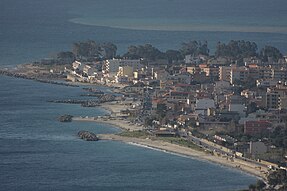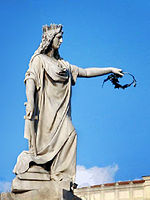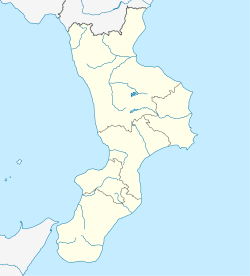
Back Reggio Calabria AN رية قلورية Arabic ريدجو كالابريا ARZ Reggio Calabria AST Reggio Calabria AVK Recco Kalabriya Azerbaijani رجو کالابریا AZB Reggio Calabria BCL Рэджа-ды-Калабрыя Byelorussian Реджо ди Калабрия Bulgarian
This article needs additional citations for verification. (November 2021) |
Reggio Calabria
| |
|---|---|
| Città di Reggio Calabria | |
Clockwise from top: Aerial view, Lungomare Falcomatà, Castello Aragonese, the historical Roman baths of Reggio Calabria, Monument to Victory in Arena dello stretto, Giuseppe Garibaldi square and the Centrale railway station, Reggio Calabria Cathedral, statue in Piazza italia | |
| Nickname: the city of Fata Morgana | |
| Coordinates: 38°06′41″N 15°39′43″E / 38.11139°N 15.66194°E | |
| Country | Italy |
| Region | Calabria |
| Metropolitan city | Reggio Calabria (RC) |
| Government | |
| • Mayor | Giuseppe Falcomatà (PD) |
| Area | |
• Total | 240 km2 (90 sq mi) |
| Population | |
• Total | 170,951 |
| • Density | 710/km2 (1,800/sq mi) |
| Demonym | Reggino |
| Time zone | UTC+1 (CET) |
| • Summer (DST) | UTC+2 (CEST) |
| Postal code | 89100 (generic) from 89121 to 89135 |
| Dialing code | 0039 0965 |
| ISTAT code | 080063 |
| Website | reggiocal.it |
Reggio di Calabria[a] (Southern Calabrian: Riggiu; Calabrian Greek: Ρήγι, romanized: Rìji), commonly and officially referred to as Reggio Calabria, or simply Reggio by its inhabitants, is the largest city in Calabria as well as the seat of the Regional Council of Calabria.[10] It has an estimated population between 150,000 and 200,000 and is the twenty-first most populous city in Italy, after Modena and other Italian cities, and the 100th most populated city in Europe. Reggio Calabria is located near the center of the Mediterranean and is known for its climate, ethnic and cultural diversity. It is the third economic centre of mainland Southern Italy. About 560,000 people live in the metropolitan area, recognised in 2015 by Italy as a metropolitan city.[11] It holds the record of the worst city in terms of quality of life for environmental and cultural parameters, ranking among the worst Italian cities for quality of life.[12]
| Year | Pop. | ±% |
|---|---|---|
| 1861 | 54,807 | — |
| 1871 | 62,613 | +14.2% |
| 1881 | 68,178 | +8.9% |
| 1901 | 77,761 | +14.1% |
| 1911 | 76,320 | −1.9% |
| 1921 | 98,221 | +28.7% |
| 1931 | 109,443 | +11.4% |
| 1936 | 119,804 | +9.5% |
| 1951 | 140,734 | +17.5% |
| 1961 | 153,380 | +9.0% |
| 1971 | 165,822 | +8.1% |
| 1981 | 173,486 | +4.6% |
| 1991 | 177,580 | +2.4% |
| 2001 | 180,353 | +1.6% |
| 2011 | 180,817 | +0.3% |
| 2021 | 172,479 | −4.6% |
| Source: ISTAT | ||
Reggio is located on the "toe" of the Italian Peninsula and is separated from the island of Sicily by the Strait of Messina. It is situated on the slopes of the Aspromonte, a long, craggy mountain range that runs up through the centre of the region.
As a major functional pole in the region, it has strong historical, cultural and economic ties with the city of Messina, which lies across the strait in Sicily, forming a metro city of less than 1 million people.[13]
Reggio is the oldest city in the region, and during ancient times, it was an important and flourishing colony of Magna Graecia. Reggio has a modern urban system, set up after the catastrophic earthquake of 1908, which destroyed most of the city. Before that seismic event, the region has been subject to several other previous earthquakes.[14] The seismicity is caused by Reggio being on the Eurasian Plate near the faultline where it meets the African Plate that runs through the strait, dividing the two European regions of Calabria and Sicily into two different tectonic regions.[15][16]
It is a major economic centre for regional services and transport on the southern shores of the Mediterranean. Reggio, with Naples and Taranto, is home to one of the most important archaeological museums, the prestigious National Archaeological Museum of Magna Græcia, dedicated to Ancient Greece (which houses the Bronzes of Riace, rare example of Greek bronze sculpture, which became one of the symbols of the city). Reggio is the seat, since 1907, of the Archeological Superintendence of Bruttium and Lucania. The city is home to football club Reggina, that previously played in the Italian top flight.
The city centre, consisting primarily of Liberty buildings, has a linear development along the coast with parallel streets, and the promenade is dotted with rare magnolias and exotic palms. Reggio has commonly used popular nicknames: The "city of Bronzes", after the Bronzes of Riace that are testimonials of its Greek origins; the "city of bergamot", which is exclusively cultivated in the region; and the "city of Fatamorgana", an optical phenomenon visible in Italy only from the Reggio seaside.[citation needed]
- ^ Spanò Bolani, Domenico (1857). Storia di Reggio da' Tempi Primitivi sino all'anno di Cristo 1797. Stamperia e Cartiere del Fibreno, Napoli, 1857. ISBN 8874481535.
- ^ Spanò Bolani, Domenico (1857). Storia di Reggio da' Tempi Primitivi sino all'anno di Cristo 1797. Stamperia e Cartiere del Fibreno, Napoli, 1857. ISBN 8874481535.
- ^ "Superficie di Comuni Province e Regioni italiane al 9 ottobre 2011". Italian National Institute of Statistics. Retrieved 16 March 2019.
- ^ "Reggio di Calabria (Reggio di Calabria, Calabria, Italy) - Population Statistics, Charts, Map, Location, Weather and Web Information".
- ^ "Popolazione Residente al 1° Gennaio 2018". Italian National Institute of Statistics. Retrieved 16 March 2019.
- ^ "Reggio di Calabria". The American Heritage Dictionary of the English Language (5th ed.). HarperCollins. Retrieved February 9, 2019.
- ^ "Reggio di Calabria"[dead link] (US) and "Reggio di Calabria". Lexico UK English Dictionary. Oxford University Press. Archived from the original on 2022-08-26.
- ^ "Reggio". Merriam-Webster.com Dictionary. Merriam-Webster. Retrieved February 9, 2019.
- ^ "Dizionario d'ortografia e di pronunzia". Archived from the original on 2021-06-06. Retrieved 2014-03-23.
- ^ "Consiglio regionale della Calabria".
- ^ "E Reggio Calabria diventa "metropoli"". Retrieved 26 March 2015.
- ^ "Qualità della vita 2023: la performance di Reggio-Calabria | Il Sole 24 ORE". www.ilsole24ore.com (in Italian). Retrieved 2024-06-25.
- ^ "Area dello Stretto: Messina rilancia". Archived from the original on September 17, 2013. Retrieved 26 March 2015.
- ^ Corno, Massimo. "L'Italia è un paese ad alto rischio sismico - Protezione Civile Imbersago".
- ^ "Southern Italy: Earthquake hazard due to active plate boundary". Phys.org. 24 January 2017. Retrieved 5 September 2022.
- ^ "What caused the Messina earthquake?". Finestra Informativa. 26 January 2022. Retrieved 5 September 2022.
Cite error: There are <ref group=lower-alpha> tags or {{efn}} templates on this page, but the references will not show without a {{reflist|group=lower-alpha}} template or {{notelist}} template (see the help page).












